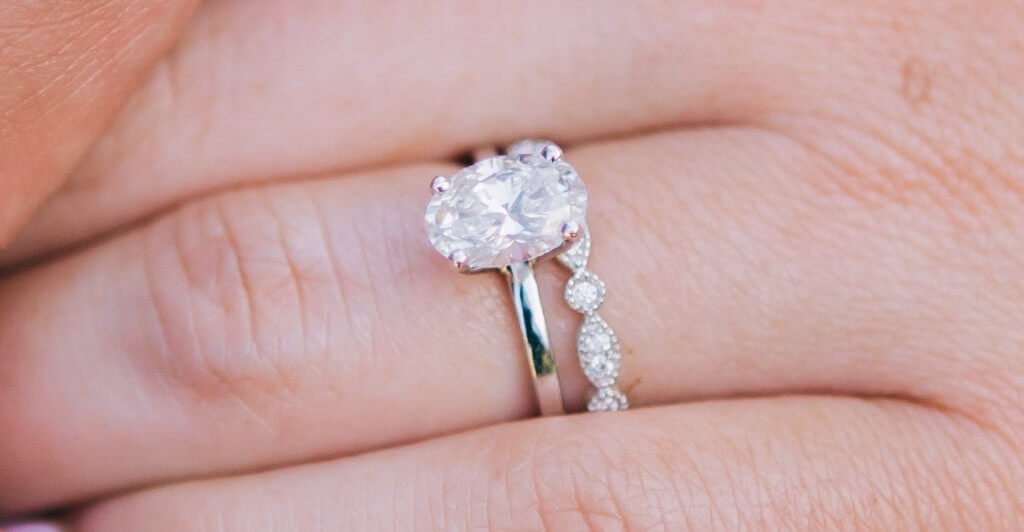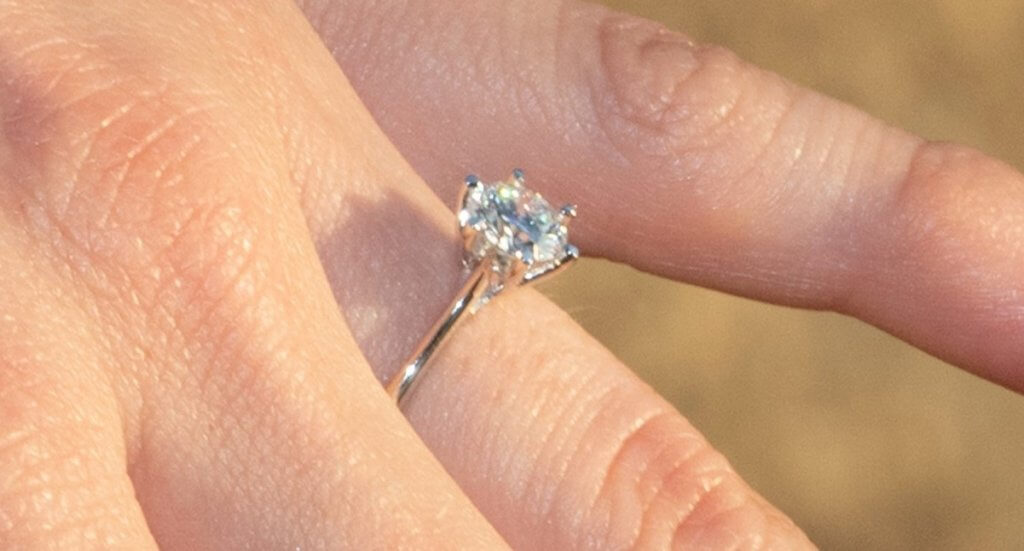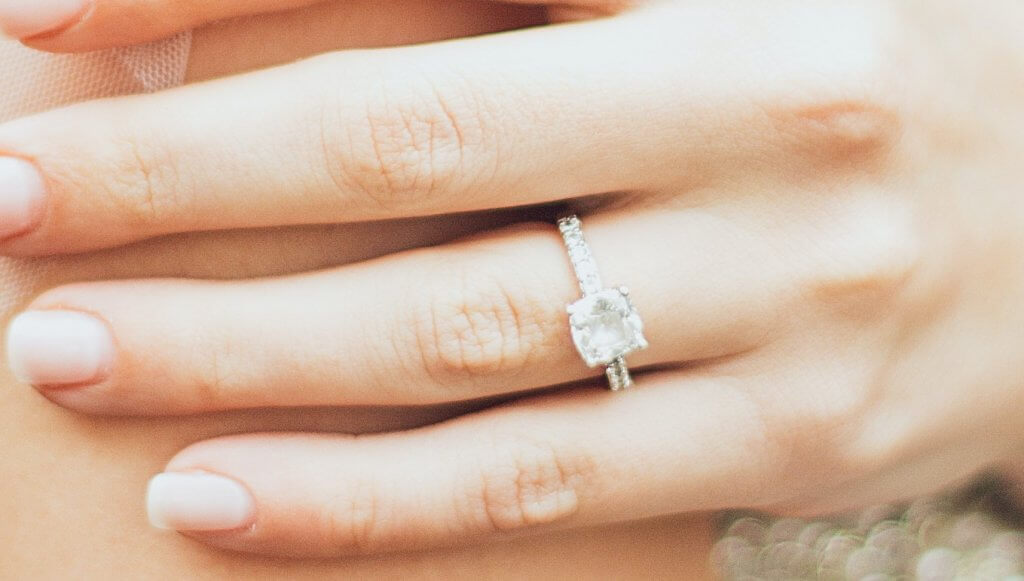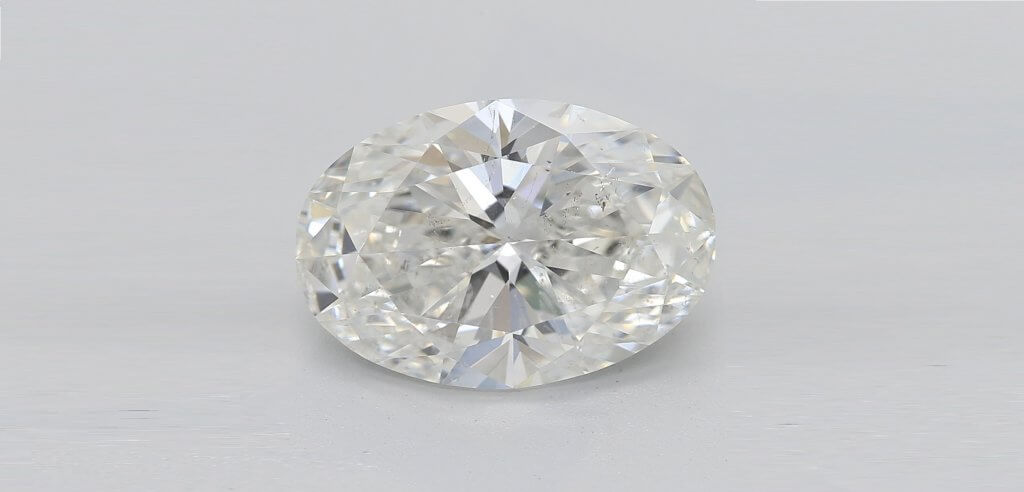Choosing G Color Diamonds: A Complete Guide
Key Takeaways
- There is no right or wrong grade when going for that perfect diamond for your engagement ring.
- The G grade is close to the top, and often the most affordable option.
- It is the highest grade in the Near Colorless range, which means that you won’t be able to see any yellowing or discoloration under a natural light.
- Of course, it is not perfect, but going for perfect means you will likely sacrifice one of the other Four Cs.
- A G diamond can be a strong option, but you don’t need to stick rigidly to this grade. Even in H and I color diamonds, it will be hard to tell that the diamond is not colorless, which is, ultimately, what’s most important.

Diamond color is one of those topics that can easily cause confusion among shoppers who are new to the four Cs as, unless you’re specifically looking for a fancy colored diamond in blue or pink, it doesn’t sound like it should affect you all that much.
Very quickly, however, we all come to realize that color is just as significant as any of the rest of the four Cs, and that a poor choice of color grade can significantly impact the appearance of your diamond, and the finished engagement ring.
Like inclusions, color is seen as a negative feature within any clear diamond. It can present as a very light, watered-down yellow, or as a definite brown-cast within the stone. And, while this is entirely natural – and a fascinating part of a diamond’s billion-year history – it’s definitely not what the majority of shoppers are looking to place on the finger of their bride-to-be.
G Color Diamonds sit a few grades from the top, but close enough that many shoppers are drawn to them for their lower cost. But, are they the best choice for you? Here’s our guide…
- The G Color Grade
- What Does G Color Mean for Diamonds?
- Is a G Color Diamond Good?
- Is F Better than G in Diamonds?
- Do G Color Diamonds Look Yellow?
- Do Colorless Diamonds Sparkle More?
- G Color and Price
- Are G Color Diamonds Cheaper than D Color Diamonds?
- Are G Color Diamonds Worth the Price?
- Is a G Color Diamond a Good Investment?
- G Color vs Clarity
- Is G SI1 a Good Diamond?
- Our Summary
The G Color Grade
Sure, we could jump straight to telling you that a G Color diamond is a great place to set your sights on if you’re looking for a beautiful diamond, but, as you’ve probably realised by now, it’s much, much better to understand the basics before you jump to any conclusion. There’s no definitive ‘right’ or ‘wrong’ way – but this is a great place to start.
What Does G Color Mean for Diamonds?
A G Color Diamond is considered ‘Near Colorless’, and close enough to colorless that you are not going to be able to see the discoloration under usual lighting, even though it’s there.
The color grade system begins at D and, from there, decreases all the way down to Z. These grades are divided into categories ranging from colorless (D to F Color Diamonds) all the way to Light Yellow (S to Z Color Diamonds).
Being the fourth grade from the top, G Color Diamonds represent the highest grade in the category known as ‘Near Colorless’, which ends on grade J. This particular category is considered a great focus point for shoppers looking to make a wise investment into their diamond’s quality and appearance, since these diamonds are considerably more affordable and, at the same time, negligibly different in appearance.
For instance, only an expert gemologist, using the right lighting and magnification, would be able to detect the difference between this 1.2 Carat G Color VS1 Oval Diamond, and this 1.2 Carat F Color VS1 Oval Diamond. The only way you would be able to tell the difference (unless you read the diamond’s GIA report) would be via the diamonds’ different price tags.
Is a G Color Diamond Good?
Yes, both with regards to diamond quality, and to making a strong investment that checks all the boxes in terms of cut, clarity, color, and carat weight without sacrificing affordability. It’s not perfect, but, without a lab and a microscope, it may as well be.
Making your diamond fit with your budget is the biggest challenge you will face during your time engagement ring shopping, but a G Color Diamond is a great place to start. The difference between Near Colorless diamonds and Colorless diamonds is pretty significant, after all.
When it comes to working out where to focus the lion’s share of your money, the question often boils down to diamond color vs clarity – or, more specifically, which of these two Cs deserves more attention and investment when it comes time to buy.
And, while it’s important you pick a diamond that doesn’t show any visible signs of yellowing, the difference between Colorless and Near Colorless is far too minor to have a negative impact on the visual appeal of the diamond.
So, yes, a G Color diamond is probably one of the top grades to pick if you’re looking to make a good investment without blowing the bank on the highest possible grades.
Is F Better Than G in Diamonds?
Objectively, yes, F falls into the top category known as ‘colorless’, and is one grade higher than G. To the naked eye, however, it’s unlikely many of us would be able to confidently say that an F color diamond is better than a G color diamond.
It’s one thing for a diamond’s GIA report to document its precise color grade, but it’s another thing entirely for the diamond to look noticeably different to another. You’d have to be looking at two diamonds with a much more significant color grade difference in order to detect any meaningful change in coloration.
So, in essence, while an F Color Diamond is objectively better than a G Color Diamond, there’s so little difference between the two that, for the average shopper, that minor improvement in terms of color is simply not worth the higher cost.

Do G Color Diamonds Look Yellow?
Yes, but only if you’re looking at them under ideal light conditions. Even then, the yellow tint will be incredibly minor, and not enough to have a negative impact on the diamond during wear.
When a diamond’s GIA Report is created, it is scrutinized heavily under lab conditions, and by someone who has trained for many, many years to be able to detect the subtle nuances that exist between two seemingly identical diamonds.
In order for a diamond to be graded anywhere below a D Color, it has to contain some yellow – but you have to go pretty far down the scale before you’ll be able to detect it under normal lighting, and with your naked eye.
In other words, minor discrepancies in color are perfectly fine. They won’t interrupt the natural beauty of diamond, nor will they look off-color – for that, you’d have to be looking at diamonds a few grades lower on the color scale (around K and below).
G Color and Price
It’s all well and good us telling you that G Color Diamonds look beautiful, but, as with any aspect of diamond buying, it’s also got to be a realistic goal in terms of your budget. So, appearances aside, here’s what you need to know about the relationship with G Color Diamonds, and wise investments.
Are G Color Diamonds Cheaper than D Color Diamonds?
Yes, a D Color diamond will likely cost hundreds of dollars more than a G Color Diamond of otherwise comparable quality.
Each of the color grades commands its own price, with D being by far the most expensive. Since they belong to the ‘Near Colorless’ category, G Color Diamonds will cost significantly less than D, E and F Diamonds, while still garnering a premium price for their proximity to those top grades.
Of course, G Color diamond’s aren’t going to be thousands of dollars cheaper, since jewelers are aware that many shoppers will lean toward this grade, rather than the very highest grades possible. Even so, you’ll be able to find a competitively priced G Color Diamond, without overpaying for quality you won’t notice.

Are G Color Diamonds Worth the Price?
Yes, many experienced jewelers often consider G Color diamonds to represent an ideal middle ground between total colorlessness, and affordability. That way, you can channel more of your budget toward positive attributes, such as size and cut.
It goes without saying that a Color Grade of D will drive up the price more than any other color grade, and that two diamonds of otherwise comparable quality will be priced totally differently if one has been graded D Color and the other, say, J or K.
As a result, a G Color diamond, while cheaper than D, E or F Color Diamonds, will also be noticeably more expensive than any diamonds that fall below it on the color scale (provided they’re of similar quality in terms of cut, color, and clarity).
Still, it will also be significantly cheaper than one of the colorless grades (D, E, or F), which means that shoppers can strike a pretty advantageous balance between the premium cost of a diamond that has been graded at the very top of the scale, and the lower cost of diamonds that bear a more discernible yellow tint.
When it comes to the four Cs, many first-time buyers are reluctant to sacrifice the very highest grades, since they offer objective confirmation that a diamond is ‘good’. Still, this is a big mistake, since it’ll probably force you into a corner and mean that you have to settle for a much smaller diamond in order to stay true to your budget.
You can, however, go too far in the right direction. Just as we recommend a diamond with a clarity grade of VS over a smaller diamond with a VVS clarity grade, we would always recommend aiming a little lower than ‘Colorless’, as doing so will free up more money for the more noticeable aspects of a diamond’s quality: cut and carat weight.
Is a G Color Diamond a Good Investment?
Yes, it’s a great color grade to set your sights on when you start hunting for the perfect diamond to sit in your engagement ring.
When it comes to color, it’s all too easy to go too far in one direction – or too far in the other direction. You don’t want a yellow-looking diamond, as that can significantly impair the beauty of an otherwise stunning diamond, but you also don’t want to pay more than you need to. And, since the top color grades can only be ascribed under the right testing conditions and with the right equipment, it’s important to find that sweet spot.
G Color diamonds represent the ideal sweet spot if you want to find that quality without paying over the odds – something the overwhelming majority of diamond shoppers are looking to achieve.
G Color and Clarity
As always, color and clarity are two features that need to be considered very carefully during the process of hunting for the right diamond. Avoiding the two most significant flaws a diamond can suffer from – discoloration and inclusions – is very important to making a good choice, but that’s not to say it’s always easy.
Is G SI1 a Good Diamond?
It’s not ideal, but it would be possible to find an eye clean diamond – although it would need to be on the smaller side. For, while a G Color diamond is definitely where you want to be in terms of color, the flaws found in SI1 diamonds can significant enough to impact the appearance of the diamond if it is more than 2.0 carats in weight.
When it comes to the debate over SI1 vs VS2, the higher clarity of VS2 will inevitably win out over SI1 if you’re looking to get the best quality possible. Narrowing your sights on a clarity grade of VS2 means you’ll find it much easier to track down an eye clean diamond, whereas SI1 will feature visible inclusions – although they will be pretty minor. For many, however, sacrificing eye cleanliness is not an option.
Yes, you might have to sacrifice some carat weight to find an affordable G-VS2 Diamond but, in doing so, you can feel much more confident that the overall quality and visual impact of the diamond will be stronger.
SI1 is, however, a good choice if you’re more committed to getting the largest diamond possible. If this is the case for you, then you’ll definitely want to opt for a very good color grade, such as G, in order to ensure that the larger carat weight of the diamond does not draw more attention to any discoloration – particularly if your diamond features a Cushion or Emerald cut, as these can display yellow more vividly. For instance, we’re willing to bet that you can’t detect any yellowing in this 3 Carat G-SI1 Cushion Diamond.
This is why it’s so important to visit with your local jeweler in person, whatever you’re leaning towards in terms of color and clarity. Striking the ideal balance for you takes time, but it also makes checking the diamond in person an absolute necessity.
Our Summary: Is G Color a Good Diamond?
While ‘good’ diamonds are those that hold a strong grade across each of the four Cs, a grade of G is an excellent choice as far as the stone’s color is concerned. Just don’t forget about the significance of a good clarity, cut and carat weight, too.
Yes, it will always, always be tempting to push your limits and go for a color grade of D – or, in the very least, one that falls into the top category of Colorless diamonds. There is nothing inherently wrong with this, and we can all understand why so many still feel the draw of objective perfection.
Still, very few of us can really afford to take a ‘go big or go home’ approach to buying a diamond engagement ring, and certain concessions have to be made in order to ensure it’s the best ring for you and your partner.
A color grade of G is one of those ideal concessions, since, as far as you are concerned (or anyone else who is not an experienced and discerning gemologist) the difference between that and a D Color Diamond exists in name only.
But you don’t have to put all your faith in us. During your consultation with your jeweler, you will be able to see quite how much (or, more accurately, little) a diamond is impacted by this color grade. The diamond’s GIA Report can certainly tell you a lot about its value, but there is nothing capable of matching the value of seeing it with your own eyes.

Jul 18, 2022 By Willyou.net
What You Didn’T Know About I Color Diamonds

Sep 9, 2021 By Willyou.net
Everything You Need to Know About E Color Diamonds








